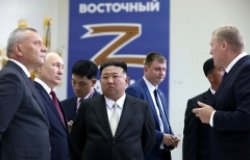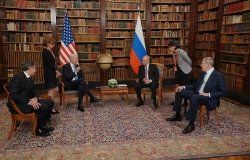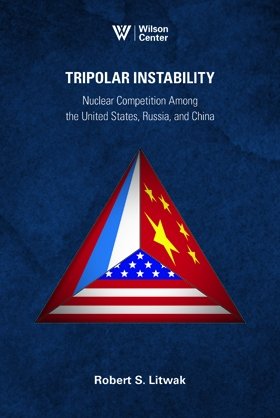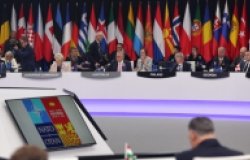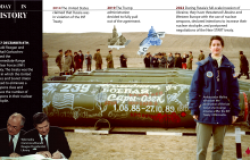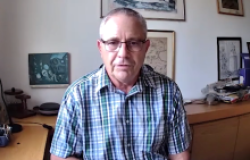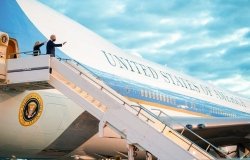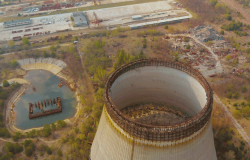The Origins of the Budapest Memorandum and the Future of Order in Europe | A Conversation with George F. Kennan Fellow George E. Bogden

Wikimedia Commons/William J. Clinton Presidential Library
Q: Describe your background and what brought you to the Wilson Center.
I am a researcher and writer on international affairs, focused on the history of Central and Eastern Europe. At the moment, I am working in the area of diplomatic history, drawing on documents from five countries and interviews with over 46 retired diplomats. Collecting these materials, organizing, and analyzing them are just the first part of my efforts. Constructing themes and ultimately generating a narrative around my subject—those are the tasks to which I am now dedicating most of my time.
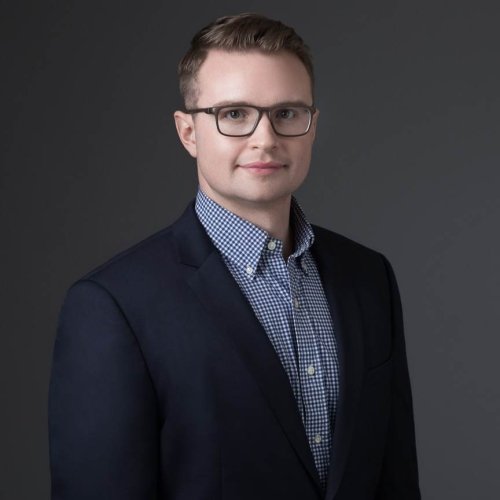
Courtesy of George E. Bogden
Spending approximately eight years abroad in Turkey, Hungary, the Balkans, and elsewhere has informed my research agenda in several areas of global politics and law. The Wilson Center generously supports scholars like me, interested in public policy debates, who are attempting to bring their skills in academic research positively to bear on important aspects of U.S.-Russian and U.S.-Ukrainian relations. I am grateful for the welcoming community I have found here. In my first week, I uncovered several new sources and databases that I had not previously considered consulting. That’s a testament to the tremendous value of my current affiliation.
Q: What project are you working on at the Center?
Serhii Plokhy concludes The Gates of Europe with a prediction. Published after Crimea’s 2014 annexation, this magisterial history of Ukraine notes Russia’s invasion violated, among other accords, “the Budapest Memorandum of 1994, which had offered Ukraine security assurances in exchange for giving up its nuclear weapons.” Plokhy’s epilogue claims “the unprovoked Russian aggression against Ukraine threatened the foundations of international order,” adding “on its resolution depends not only the future of Ukraine but also that of relations between Europe’s east and west—Russia and the European Union—and thus the future of Europe as a whole.” Over two years, I have investigated the agreement mentioned in this passage, drafting two-thirds of a monograph on its origins and implementation. I have come to the Wilson Center to finish this work, visiting several archives in Washington, DC.
For a time, the Budapest Memorandum on Security Assurances became a footnote in history. Among a generation of disarmament experts, it once embodied a shining achievement. The Cold War’s victors persuaded the heir to the world’s third largest atomic arsenal not to be “born nuclear.” Ukraine agreed to forfeit warheads installed by the Soviet Union in exchange for aid and “assurances” about the integrity of its newly sovereign territory. Russia’s revanchism recast this parable. Failure to remedy Ukraine’s fate has become a haunting demurral heard round the world.
Q: How did you become interested in your current research topic?
Years ago, when I was working on my doctoral dissertation, I selected Ukraine as a case study. I was studying then what is referred to in international law as “treaty succession.” The topic relates to decisions by states to accept or renounce treaties signed on their behalf by predecessor political entities. In the 1990s, Ukraine’s circumstances as a newly-independent state required that it decide which international obligations, taken on when it was part of the USSR, would be maintained after it became independent. As you might imagine, documenting this aspect of its history was a gargantuan task. It involved an extended period of methodical work to digest all of Kyiv’s early decisions in this regard. I came across several sources dealing not only with the Nonproliferation Treaty, but also the Budapest Memorandum. I immediately sensed that there was an important backstory to be told about this topic. I slowly gathered information for a few years, writing a grant proposal about 18 months before the current hostilities in Ukraine broke out. That initial seed funding, from the Smith Richardson Foundation, proved extremely important. It allowed me to conduct my foundational archival research.
Q: Why do you believe that your research matters to a wider audience?
There are several key aspects of my research that should draw the attention of the general public as well as seasoned foreign policy thinkers. My manuscript combines riveting subjects—in history, diplomacy, and domestic politics—to address the origin of a story that has been in the news for years: the fate of Ukraine since Russia’s invasion. The tale I have set out to tell involves the dissolution of the Soviet Union and the extent to which decisions made at that time set the world up for the current crisis. Addressing those issues inherently involves entering certain debates about nuclear weapons. Is it always best for fewer states to have them? Do they provide a real deterrent against conflict? If a state must be coaxed to give them up, how should the international community ensure it does not fall prey to powerful nuclear armed states? All of these questions bear on this historical analysis I am undertaking. They were as salient in the 1990s as they are today.
I have had the great pleasure to engage with civil society institutions in Washington, DC, as well as in capitals across Europe, about my research. I have found that many different individuals, governments, and societies have complicated views on these core questions. They also maintain distinct understandings of the historical moment I am evaluating. To the extent my work can serve as a bridge to discussions across borders, I think that will make the project a more inclusive one. In shorter publications, I have tried to undertake that role as I build my narrative about the Budapest Memorandum.
Q: What is the most challenging aspect of your research?
The historical research I am pursuing touches upon certain deeply held beliefs among the foreign policy community of the United States. Memories and conclusions about the success of past decisions—namely to denuclearize former Soviet satellite republics swiftly after their independence—have calcified into mantras. As a result, I have become sensitive to the need to avoid straw men arguments. In other words, when I am dealing with other historical accounts I avoid misrepresenting their arguments so as to ensure they are easier to defeat than the actual arguments made. I also insist on this when my own work is characterized. Suggesting Ukraine did not receive adequate security assurances in exchange for giving up its nuclear weapons is not the same thing as insisting the country should have kept its inherited nuclear arsenal. Too often, I think, this prefatory point has to be repeated. I am inspired when I face this kind of quandary by the words of my fellowship’s namesake: “the truth is sometimes a poor competitor in the market place of ideas – complicated, unsatisfying, full of dilemmas, always vulnerable to misinterpretation and abuse.” George Kennan knew how hard it was to scrutinize a cherished consensus. My project must do that to succeed.
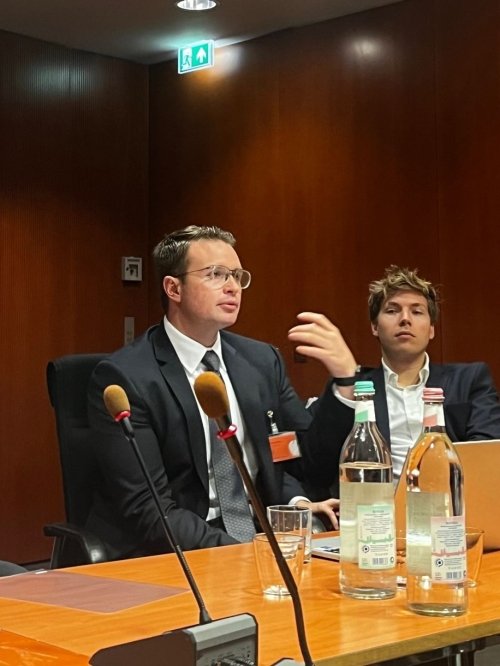
Courtesy of George Bogden
Q: What do you hope the impact of your research will be?
In his beautiful book written before Russia’s 2022 incursions, Tim Judah captured what I think is at stake in studies like mine. “Today,” he says In Wartime, “what you think of this past, how you relate to it, determines what you think about the future of Ukraine. And what you think of the past is quite likely to be bound up with the history of your own family and where you live.” As an American descended from Central and Eastern Europeans, who has spent many years in that region, I admit my work draws on certain fragments of my biography.
As a result, there are two areas where I hope my study will contribute to ongoing discussions. The first pertains to the purely historical questions I address. How do we understand Ukraine’s decision to give up the weapons left on its territory? What combination of factors contributed to that outcome? It is far too easy, in my view, to rely on an explanation that chooses just one variable or one side of the story. There are many voices that have not been heard—either buried in the archival record or ignored by researchers unwilling to acknowledge persistent, anguished dissent. When future students, scholars, and members of the public seek a resource on Ukraine’s decision to disarm, I hope my text provides them with an accessible and valuable starting point.
In a larger sense, I aspire to influence the debate about nuclear policy. What is happening now on the battlefields east of the Dnipro River will remain an unhappy aspect of the legacy of nonproliferation achieved after the cold war. Even if one adamantly concludes that Ukraine’s disarmament was something close to inevitable, the aftermath of that decision should give pause to advocates for sweeping nonproliferation. Obeisance to their principles has perhaps led to the violence they seek to prevent.
The opinions expressed in this article are those solely of the author and do not reflect the views of the Kennan Institute.
About the Author


Kennan Institute
The Kennan Institute is the premier US center for advanced research on Russia and Eurasia and the oldest and largest regional program at the Woodrow Wilson International Center for Scholars. The Kennan Institute is committed to improving American understanding of Russia, Ukraine, Central Asia, the Caucasus, and the surrounding region though research and exchange. Read more


